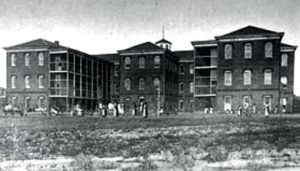
Exercise Yard at the Oregon State Insane Asylum, circa 1905, courtesy Mental Health Association of Portland
Besides the humanitarian reasons to create asylums–which included more success in curing insanity than any family attempts could hope to achieve–supporters could also point out solid savings for the states which funded them.
By the time asylums became popular for the care and treatment of insanity, states had accepted responsibility for citizens who had no means of support or who caused undesirable disruptions in society. Early on, many of the insane wound up in jails because they had no families or their families simply could not give them proper care. Violent cases, of course, were the most problematic for families to handle.

Willard Asylum Patients Working in the Sewing Room
Asylums were able to hold costs down by using patient labor on a much wider scale than most city or county jails could. Many asylums grew their own food and made or manufactured necessities like clothes and shoes. Charities, clubs, and individuals were far more likely to provide amenities (newspapers and magazines, concerts, clothing, etc.) to asylums than to jails, and states generally could provide the insane better care at less expense in asylums than regional jails.

Central Lunatic Asylum
The Central Lunatic Asylum in Virginia had filled almost as soon as it opened, and after only four months of operation, its first Board of Directors pleaded for money to build additional wards so they could take in patients who had been turned away for lack of space. After making a case for more appropriations based on humanity and the higher quality of care found in asylums versus jails, the Board also said:
“Besides the plea of humanity, economy may be urged as a reason for granting the appropriation. It will cost less to support the colored insane at the Asylum than in the county jails, and the prospect of relieving the State of all expense in each case is increased by promptly affording the Patient the benefits of the Asylum.”